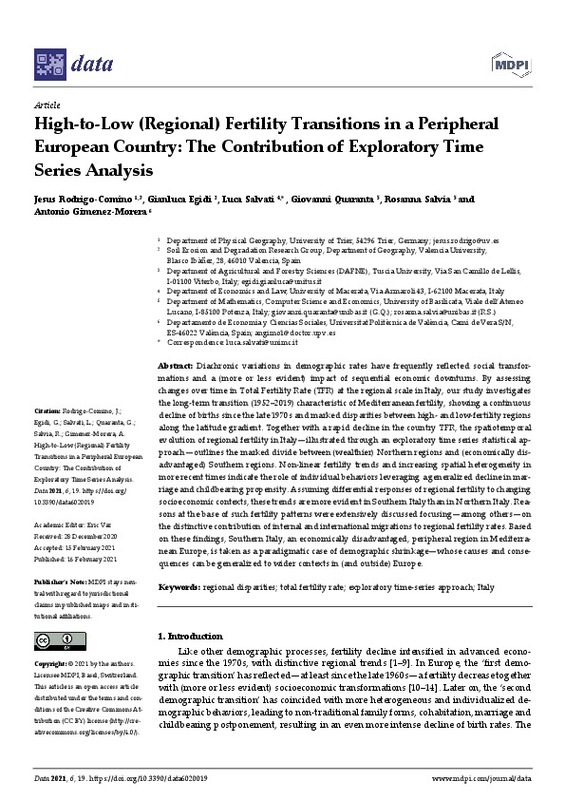JavaScript is disabled for your browser. Some features of this site may not work without it.
Buscar en RiuNet
Listar
Mi cuenta
Estadísticas
Ayuda RiuNet
Admin. UPV
High-to-Low (Regional) Fertility Transitions in a Peripheral European Country: The Contribution of Exploratory Time Series Analysis
Mostrar el registro sencillo del ítem
Ficheros en el ítem
| dc.contributor.author | Rodrigo-Comino, Jesús
|
es_ES |
| dc.contributor.author | Egidi, Gianluca
|
es_ES |
| dc.contributor.author | Salvati, Luca
|
es_ES |
| dc.contributor.author | Quaranta, Giovanni
|
es_ES |
| dc.contributor.author | Salvia, Rosanna
|
es_ES |
| dc.contributor.author | Giménez Morera, Antonio
|
es_ES |
| dc.date.accessioned | 2022-04-05T06:54:53Z | |
| dc.date.available | 2022-04-05T06:54:53Z | |
| dc.date.issued | 2021-02 | es_ES |
| dc.identifier.uri | http://hdl.handle.net/10251/181785 | |
| dc.description.abstract | [EN] Diachronic variations in demographic rates have frequently reflected social transformations and a (more or less evident) impact of sequential economic downturns. By assessing changes over time in Total Fertility Rate (TFR) at the regional scale in Italy, our study investigates the long-term transition (1952-2019) characteristic of Mediterranean fertility, showing a continuous decline of births since the late 1970s and marked disparities between high- and low-fertility regions along the latitude gradient. Together with a rapid decline in the country TFR, the spatiotemporal evolution of regional fertility in Italy-illustrated through an exploratory time series statistical approach-outlines the marked divide between (wealthier) Northern regions and (economically disadvantaged) Southern regions. Non-linear fertility trends and increasing spatial heterogeneity in more recent times indicate the role of individual behaviors leveraging a generalized decline in marriage and childbearing propensity. Assuming differential responses of regional fertility to changing socioeconomic contexts, these trends are more evident in Southern Italy than in Northern Italy. Reasons at the base of such fertility patterns were extensively discussed focusing-among others-on the distinctive contribution of internal and international migrations to regional fertility rates. Based on these findings, Southern Italy, an economically disadvantaged, peripheral region in Mediterranean Europe, is taken as a paradigmatic case of demographic shrinkage-whose causes and consequences can be generalized to wider contexts in (and outside) Europe. | es_ES |
| dc.language | Inglés | es_ES |
| dc.publisher | MDPI AG | es_ES |
| dc.relation.ispartof | Data | es_ES |
| dc.rights | Reconocimiento (by) | es_ES |
| dc.subject | Regional disparities | es_ES |
| dc.subject | Total fertility rate | es_ES |
| dc.subject | Exploratory time-series approach | es_ES |
| dc.subject | Italy | es_ES |
| dc.subject.classification | COMERCIALIZACION E INVESTIGACION DE MERCADOS | es_ES |
| dc.title | High-to-Low (Regional) Fertility Transitions in a Peripheral European Country: The Contribution of Exploratory Time Series Analysis | es_ES |
| dc.type | Artículo | es_ES |
| dc.identifier.doi | 10.3390/data6020019 | es_ES |
| dc.rights.accessRights | Abierto | es_ES |
| dc.contributor.affiliation | Universitat Politècnica de València. Departamento de Economía y Ciencias Sociales - Departament d'Economia i Ciències Socials | es_ES |
| dc.description.bibliographicCitation | Rodrigo-Comino, J.; Egidi, G.; Salvati, L.; Quaranta, G.; Salvia, R.; Giménez Morera, A. (2021). High-to-Low (Regional) Fertility Transitions in a Peripheral European Country: The Contribution of Exploratory Time Series Analysis. Data. 6(2):1-14. https://doi.org/10.3390/data6020019 | es_ES |
| dc.description.accrualMethod | S | es_ES |
| dc.relation.publisherversion | https://doi.org/10.3390/data6020019 | es_ES |
| dc.description.upvformatpinicio | 1 | es_ES |
| dc.description.upvformatpfin | 14 | es_ES |
| dc.type.version | info:eu-repo/semantics/publishedVersion | es_ES |
| dc.description.volume | 6 | es_ES |
| dc.description.issue | 2 | es_ES |
| dc.identifier.eissn | 2306-5729 | es_ES |
| dc.relation.pasarela | S\428990 | es_ES |








